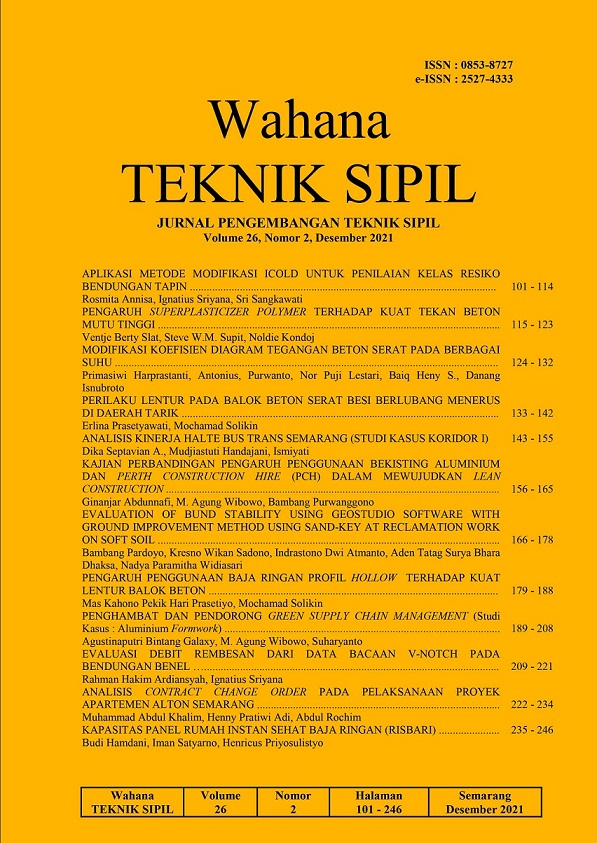PENGARUH PENGGUNAAN BAJA RINGAN PROFIL HOLLOW TERHADAP KUAT LENTUR BALOK BETON
DOI:
https://doi.org/10.32497/wahanats.v26i2.3132Keywords:
flexural strength, hollow beam, hollow profile light steel, economicalAbstract
When a load given to a concrete beam, the upper part of the beam will receiving compressive force, while the bottom holds tensile force. The maximum compressive force in the upper part of the beam gradually decreases to zero at the neutral line and then turns into tensile force that increases to maximum at the bottom fiber of the beam. The bottom part of the concrete below the neutral line does not receive any compressive forces, so it works as a conductor for tensile forces to the reinforcement. This study was intended to determine the effect of inserting hollow steel longitudinally to the tensile area of concrete beams in order to increase the load capacity and reduce the volume of concrete simultaneously. In this study, a one-point pressure test experiment was carried out using a Loading Frame with a sample of 28 days old concrete block with f'c = 21.04 MPa measuring 12cm x 18cm x 250cm. The reinforcement configuration is 4Ø10mm with fy = 450Mpa. The beams are casted in 3 variations consist of 2 samples each, which are normal beams, beams with 4x2 hollow steel profiles, and beams with 4x4 hollow steel profiles. The hollow profile steel was not removed during the test. From laboratory tests, it was found that although the reinforced hollow beam cracked early, the load capacity increased and 7.41% lighter than normal beam. Meanwhile, from the calculation simulation concluded, that to match the strength of hollow beams reinforced with hollow profile steel, solid beams need to be more ductile so that the dimensions need to be enlarged and become more expensive. This indicate that the voids in the tensile area of the beam are economically benefit while the stiffness of the concrete beam remain the same and even increasing flexural strength when a hollow profile steel inserted.References
Alshimmeri, Ahmad Jabbar Hussain, 2014, Structural Behavior of Reinforced Concrete Hollow Beams under Partial Uniformly Distributed Load, Journal of Engineering 20(7): 130”“45.
Asroni, A., 2017, Teori Dan Desain Balok Plat Beton Bertulang Berdasarkan SNI 2847-2013, Muhammadiyah University Press.
Budi Hastono, K., 2013, Penggunaan Baja Ringan (Cold-Formed) Type Hollow Sebagai Tulangan Pada Balok Beton Bertulang Dalam Memikul Beban Lentur, KERN Jurnal Teknik Sipil 3(Mei): 21”“38.
Budi, K., 2012, Geser Lentur Balok, https://www.ilmutekniksipil.com/ struktur-beton/ geser-lentur-balok (May 24, 2021).
Dini, R., 2008, Analisis Pengaruh Dimensi Balok Dan Kolom Portal Terhadap Lebar Retak Pada Bangunan, Universitas Brawijaya Malang.
DPU, 1988, Modul Pengantar Dan Prinsip-Prinsip Perencanaan Bangunan Bawah / Pondasi Jembatan.
Noorhidana, VA; dan Purwanto, Edy, 2011, Pengaruh Pelubangan Pada Badan Balok Beton Bertulang Terhadap Kapasitas Beban Lentur, Jurnal Rekayasa 15(2) :151-162
Pratama, R.F., Budio, S.P., dan Wijaya, M.N., 2016, Analisa Kekakuan Struktur Balok Beton Bertulang Dengan Lubang Hollow Core Pada Tengah Balok, Journal Article Mahasiswa Teknik Sipil 1(2): 1”“11.
Sariman, Syahrul; Parung, Herman; Djamaludin, Rudy; dan Irmawaty, Rita, 2018, Analisis Kapasitas Lentur Balok Beton Bertulang Dengan Variasi Panjang Rongga Pada Penampang Tarik, In Prosiding Konferensi Nasional Pascasarjana Teknik Sipil (KNPTS). Institut Teknologi Bandung, 2 Oktober 2018: 31-40
SNI, 2002, Tata Cara Perhitungan Struktur Beton Untuk Bangunan Gedung, SNI 03-2847 - 2002.
SNI, 2013, Persyaratan Beton Struktural Untuk Bangunan Gedung SNI 2847 ”“ 2013.
Tjokrodimuljo, K., 1996, Teknologi Beton. Yogyakarta: Universitas Gadjah Mada
Downloads
Published
Issue
Section
License
Authors who publish with this journal agree to the following terms:Authors retain copyright and grant the journal right of first publication with the work simultaneously licensed under a Creative Commons Attribution License that allows others to share the work with an acknowledgement of the work's authorship and initial publication in this journal.
Authors are able to enter into separate, additional contractual arrangements for the non-exclusive distribution of the journal's published version of the work (e.g., post it to an institutional repository or publish it in a book), with an acknowledgement of its initial publication in this journal.
Authors are permitted and encouraged to post their work online (e.g., in institutional repositories or on their website) prior to and during the submission process, as it can lead to productive exchanges, as well as earlier and greater citation of published work (See The Effect of Open Access).






